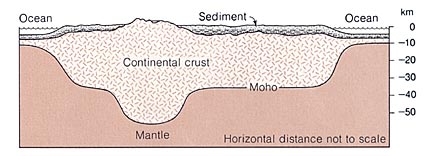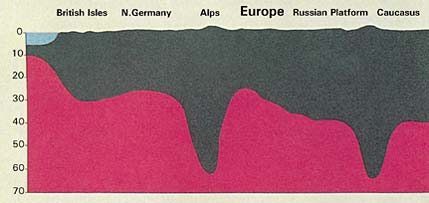The Mountains:
A book entitled Earth is a basic reference textbook in many universities around the world. One of its two authors is Professor Emeritus Frank Press. He was the Science Advisor to former US President Jimmy Carter, and for 12 years was the President of the National Academy of Sciences, Washington, DC. His book says that mountains have underlying roots. These roots are deeply embedded in the ground, thus, mountains have a shape like a peg.
Modern earth sciences have proven that mountains have deep roots under the surface of the ground and that these roots can reach several times their elevations above the surface of the ground. So the most suitable word to describe mountains on the basis of this information is the word peg, since most of a properly set peg is hidden under the surface of the ground. The history of science tells us that the theory of mountains having deep roots was introduced only in the latter half of the nineteenth century.
Mountains also play an important role in stabilizing the crust of the earth. They hinder the shaking of the earth.
Likewise, the modern theory of plate tectonics holds that mountains work as stabilizers for the earth. This knowledge about the role of mountains as stabilizers for the earth has just begun to be understood in the framework of plate tectonics since the late 1960s.
(quoted from a book)
A book entitled Earth is a basic reference textbook in many universities around the world. One of its two authors is Professor Emeritus Frank Press. He was the Science Advisor to former US President Jimmy Carter, and for 12 years was the President of the National Academy of Sciences, Washington, DC. His book says that mountains have underlying roots. These roots are deeply embedded in the ground, thus, mountains have a shape like a peg.
Modern earth sciences have proven that mountains have deep roots under the surface of the ground and that these roots can reach several times their elevations above the surface of the ground. So the most suitable word to describe mountains on the basis of this information is the word peg, since most of a properly set peg is hidden under the surface of the ground. The history of science tells us that the theory of mountains having deep roots was introduced only in the latter half of the nineteenth century.
Mountains also play an important role in stabilizing the crust of the earth. They hinder the shaking of the earth.
Likewise, the modern theory of plate tectonics holds that mountains work as stabilizers for the earth. This knowledge about the role of mountains as stabilizers for the earth has just begun to be understood in the framework of plate tectonics since the late 1960s.
(quoted from a book)



